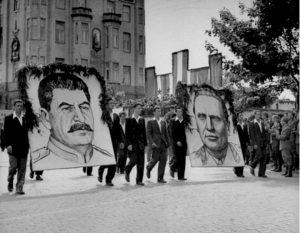
In 1947, Yugoslavia and the other “Eastern Bloc” nations strongly rejected the United States’ Marshall Plan aid at the demand of Joseph Stalin. Only one year later, in 1948, Yugoslavia’s leader, Josip Broz Tito split with Stalin and established Yugoslavia as an independent communist state. This came as a shock to much of the world, as Yugoslavia had appeared a faithful ally to the Soviets. As a result of this split, which became known as the Tito-Stalin split, Yugoslavia began receiving aid from the United States, which further complicated the United States’ approach to dealing with communism and the USSR.
The end of World War II brought the end of the Yugoslavian monarchy and ushered in a communist government under Tito. The new Yugoslavian leader was adamant about the need to set up a strong central government and in 1946, the country’s new constitution, modeled after the Soviet Union, was signed and created a new communist government. Though the Soviet Union was the model for Tito’s Yugoslavia, the two nations were constantly in conflict, stemming from disagreements over Stalin’s disapproval of Tito’s Bled Agreement with Bulgaria in 1947, and leading to a final split between the two nations in 1948.
This split left Yugoslavia in a peculiar position having left the major Communist power, but not aligning itself with the West either. Their status as a neutral nation would become an important policy tool in the future, but in the moment, it put the United States in a difficult foreign policy position. At the time of this split between Stalin and Tito, the world was moving into a post World War II dynamic, and the struggle for dominance was in full force between the rising world powers. At the beginning of the year, President Truman had delivered a speech, claiming that the United States must “support free peoples who are resisting attempted subjugation by armed minorities or by outside pressures,” and that the United States had the obligation to “assist free peoples to work out their own destinies in their own way.” He stated that this policy should come in the form of U.S. economic and financial aid, thus encouraging a similar policy solution to that of the Marshall Plan, which Yugoslavia had previously rejected. This speech set up the dynamic between the United States and the Soviet Union and was a public display of the hostility that was to come. Despite the growing ideological divides between the two nations, the United States viewed Yugoslavia’s break from the Soviet Union as a win for U.S. foregin policy and proof that their efforts to contain the power of Stalin, were working.
Media coverage of the Yugoslavian split was plastered all over the papers at the time, signalling yet another crack in the power Soviet Union. As seen by a New York Times article published soon after the split, the situation in Yugoslavia after splitting with the Soviet Union had Washington cautiously optimistic that their anti-Communist efforts were beginning to take hold and deemed the split a “gain for the Western democracies.” The article lays out observations that the Truman administration made about the split and its impact on world politics. These observations give a glimpse into Washington’s motives for their subsequent aid to post-Soviet Yugoslavia. The observations are that “it is unlikely that there will be a complete break between Belgrade and Moscow”, the Marshall Plan succeeded in “cracking the smooth facade of the Communist world”, that “the foundation of communism is not secure and that nationalism is stall a force capable of challenging communism”, and that “the cleavage has come at a critical time…and will stiffen the opposition to the Soviet efforts to drive the United States, Britain, and France out of Berlin.”
While Yugoslavia was beginning what would end up being a long road of political instability under Tito, United States policy makers found a way to view the split in a way that put U.S foreign policy on a pedestal and remain true to the anti-Communist narrative that was being spread to everyday Americans at the beginning of the Cold War.
WORKS CITED
“Current Economic Developments, Lot 70 D 467,” Document 548 Foreign Relations of the United States, 1949, Eastern Europe; The Soviet Union, Volume V, (Washington: Government Printing Office, 2010),
Leffler, Melvyn P. For the Soul of Mankind: The United States, The Soviet Union, and the Cold War. New York. Hill and Wang, 2007.
Reston, James. “Marshall Plan Cracks Bloc in East, Washington Holds: ” New York TimesJun 29, 1948: 1.
“Tito’s Revolt,” New York Times, Jul 01, 1948: 22.
Truman, Harry S. Address Before A Joint Session of Congress, March 12, 1947.
